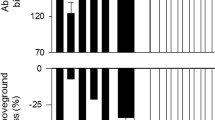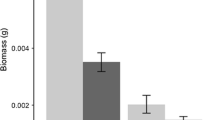Abstract
The evolution of competitive ability plays an important role in plant invasions. While many studies of the evolution of invasive species have compared populations from native and invaded ranges in terms of their performance, little attention has been paid to the evolution of intraspecific competitive ability within the invaded range during range expansion. In addition, whether the proportional change in the amount of invasive litter influences the intraspecific competitive ability among invasive populations of different ages has not yet been investigated. Here we selected Mikania micrantha H.B.K., a highly invasive vine in south China with a well-documented invasion history, as the study species. We manipulated competition among populations of different ages from the core of the range to its edges under four litter treatments in a common garden experiment. We found that during its 30-year invasion, intraspecific competitive ability was rapidly selected against towards range edges, which may be driven partly by the decline in population density. However, litter source did not influence the outcome of the competition among populations of different ages; it instead functioned more like a supply of nutrients. We suggest that stage-specific conditions such as population density should be incorporated into the experimental design when examining the evolution of invasive plants, especially when invasive populations are subject to selection on a small geographic scale. This approach can reduce sampling bias and thus improve the ability to infer the mechanisms responsible for the evolution of invasive populations.





Similar content being viewed by others
References
Armas C, Ordiales R, Pugnaire FI (2004) Measuring plant interactions: a new comparative index. Ecology 85:2682–2686
Blossey B, Nötzold R (1995) Evolution of increased competitive ability in invasive nonindigenous plants: a hypothesis. J Ecol 83:887–889
Bossdorf O, Prati D, Auge H, Schmid B (2004) Reduced competitive ability in an invasive plant. Ecol Lett 7:346–353
Bradshaw WE, Holzapfel CM (1989) Life-historical consequences of density-dependent selection in the pitcher-plant mosquito, Wyeomyia smithii. Am Nat 133:869–887
Burton OJ, Phillips BL, Travis JMJ (2010) Trade-offs and the evolution of life-histories during range expansion. Ecol Lett 13:1210–1220
Chen B, Peng S, Chen L, Li F, Wang G (2009a) Effects of aqueous extracts of Mikania micrantha HBK on nutrients release from the forests litter at three succession stages in south China. Allelopathy J 23:453–460
Chen B, Peng S, Ni G (2009b) Effects of the invasive plant Mikania micrantha HBK on soil nitrogen availability through allelopathy in South China. Biol Invasions 11:1291–1299
Colautti RI, Maron JL, Barrett SC (2009) Common garden comparisons of native and introduced plant populations: latitudinal clines can obscure evolutionary inferences. Evol Appl 2:187–199
Dietz H, Edwards PJ (2006) Recognition that causal processes change during plant invasion helps explain conflicts in evidence. Ecology 87:1359–1367
Ehrenfeld JG, Kourtev P, Huang W (2001) Changes in soil functions following invasions of exotic understory plants in deciduous forests. Ecol Appl 11:1287–1300
Evans GA, Kilkenny FF, Galloway LF (2013) Evolution of competitive ability within Lonicera japonica’s invaded range. Int J Plant Sci 174:740–748
Excoffier L, Ray N (2008) Surfing during population expansions promotes genetic revolutions and structuration. Trends Ecol Evol 23:347–351
Feng HL, Cao HL, Liang XD, Zhou X, Ye WH (2002) The distribution and harmful effect of Mikania micrantha in Guangdong. J Trop Subtrop Bot 10:263–270
Holm LG, Plucknett DL, Pancho JV, Herberger JP (1977) The world’s worst weeds. University Press of Hawaii, Honolulu
Huang F et al (2015) Rapid evolution of dispersal-related traits during range expansion of an invasive vine Mikania micrantha. Oikos 124:1023–1030
Knell RJ (2009) Population density and the evolution of male aggression. J Zool 278:83–90
Kong GH, Wu QG, Hu QM, Ye WH (2000) Further supplementary data on Mikania micrantha H.B.K. (Asteraceae). J Trop Subtrop Bot 8:128–130
Lankau RA, Strauss SY (2011) Newly rare or newly common: evolutionary feedbacks through changes in population density and relative species abundance, and their management implications. Evol Appl 4:338–353
Lankau RA, Nuzzo V, Spyreas G, Davis AS (2009) Evolutionary limits ameliorate the negative impact of an invasive plant. Proc Natl Acad Sci USA 106:15362–15367
Liao C et al (2008) Altered ecosystem carbon and nitrogen cycles by plant invasion: a meta-analysis. New Phytol 177:706–714
Lowe S, Browne M, Boudjelas S, De Poorter M (2000) 100 of the world’s worst invasive alien species: a selection from the global invasive species database. Invasive Species Specialist Group, Auckland
Maron JL, Vilà M, Arnason J (2004) Loss of enemy resistance among introduced populations of St. John’s wort (Hypericum perforatum). Ecology 85:3243–3253
Miller TE (1995) Evolution of Brassica rapa L. (Cruciferae) populations in intra- and interspecific competition. Evolution 49:1125–1133
Müller-Schärer H, Schaffner U, Steinger T (2004) Evolution in invasive plants: implications for biological control. Trends Ecol Evol 19:417–422
Ni GY, Song LY, Zhang JL, Peng SL (2006) Effects of root extracts of Mikania micrantha HBK on soil microbial community. Allelopathy J 17:247–254
Pianka ER (1970) On r-and K-selection. Am Nat 104:592–597
Pintor LM, Sih A, Bauer ML (2008) Differences in aggression, activity and boldness between native and introduced populations of an invasive crayfish. Oikos 117:1629–1636
Prentis PJ, Wilson JR, Dormontt EE, Richardson DM, Lowe AJ (2008) Adaptive evolution in invasive species. Trends Plant Sci 13:288–294
Sakai AK et al (2001) The population biology of invasive species. Annu Rev Ecol Syst 32:305–332
Shaw RG, Platenkamp GA, Shaw FH, Podolsky RH (1995) Quantitative genetics of response to competitors in Nemophila menziesii: a field experiment. Genetics 139:397–406
Wang BS, Liao WB, Zan QJ, Li MG, Zhou XY, Gao SH (2003) The spreads of Mikania micrantha in China. Acta Sci Nat Univ Sunyatseni 42:47–50
Wang BS et al (2004) The invasion ecology and management of alien weed Mikania micrantha H.B.K. Science Press, Beijing
Weidenhamer JD, Callaway RM (2010) Direct and indirect effects of invasive plants on soil chemistry and ecosystem function. J Chem Ecol 36:59–69
Ye WH, Zhou X (2001) The plant killer—Mikania micrantha in South China. Aliens 13:7
Zhang LY, Ye WH, Cao HL, Feng HL (2004) Mikania micrantha H.B.K. in China—an overview. Weed Res 44:42–49
Acknowledgments
We thank Jintian Huang, Xiuchan Fang, and Caiying Zhou for their assistance. This study was supported by the National Natural Science Foundation of China (31030015, 31070481), the Natural Science Foundation of Guangdong (S2013010012346), the Ecology Fund of Bosun Wang, and the Scientific Research Fund of Hongda Zhang, Sun Yat-sen University. The experiments comply with the current laws of P.R. China in which the experiments were performed.
Author contribution statement
FFH and SLP conceived and designed the experiments. FFH performed the experiments and analyzed the data. FFH and SLP wrote the manuscript.
Author information
Authors and Affiliations
Corresponding author
Additional information
Communicated by Wayne Dawson.
Electronic supplementary material
Below is the link to the electronic supplementary material.
Rights and permissions
About this article
Cite this article
Huang, F., Peng, S. Intraspecific competitive ability declines towards the edge of the expanding range of the invasive vine Mikania micrantha . Oecologia 181, 115–123 (2016). https://doi.org/10.1007/s00442-015-3526-9
Received:
Accepted:
Published:
Issue Date:
DOI: https://doi.org/10.1007/s00442-015-3526-9




